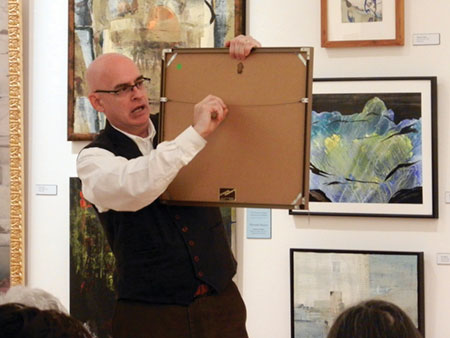
When it comes to framing – keep it simple. A wood frame is preferred, and black frames are okay. Never use glass – use plexi-glass – and always keep the work set back from the plexi-glass either through placement or matting.
Wire the painting properly. Wires should be placed two-thirds of the way up the piece and loose enough to get a hand behind it. Larger pieces (anything wider than four feet) should not be wired. Artists should use two D-rings mounted on either side of the stretcher bars.
In order to even get to the point where art needs to be framed for a show, artists need to promote themselves. An artist statement, while not mandatory, is one of the keys to charming a curator. “If I can’t explain it to a group of Girl Scouts or a bunch of retirees who are completely intimated by anything beyond Norman Rockwell, [the artwork] does me no good…I don’t want to show it,” said Metcalf.
“We don’t want to know who your influences are – any curator or gallery owner worth their salt will know,” he continued. “They’ll see the influences…Tell us what it means.”
Once an artist’s show opens, Metcalf stressed the need to “bring your friends, family, collectors, [and] potential collectors. If you can twist the arm of a local gallery dealer, commercial or non-profit, bring them. If you know somebody who works in the print media or the video media, bring them. If you have to promise them coffee or lunch, do it…You should all have good, extensive contact lists of who to get out [to the show].”
Metcalf said that artists should network and utilize social media – even when they don’t have an upcoming show. They should also create at least one self-published photo book for promotion, make a website, and get an essay written by someone other than themselves. “You need to have an essay. It doesn’t matter if it’s from a curator, or a scholar that you know – [you need] some other voice, other than you, that’s going to explain your work to the audience.”
Finally, he gave advice on how often artists should create. “[Spend time] every day painting, every day drawing, [and] every day doing something creative,” he said. “Every single day of your life you should be doing something…If you are a creator, the only way you can be vital is if you create.”
The next Coffee with the Curator is Mon., Mar. 31 from 8 to 9:30 a.m. Admission is free for museum members and $5 for non-members. Visit http://www.tritonmuseum.org/education_adults_coffeewcurator.php for more information.
